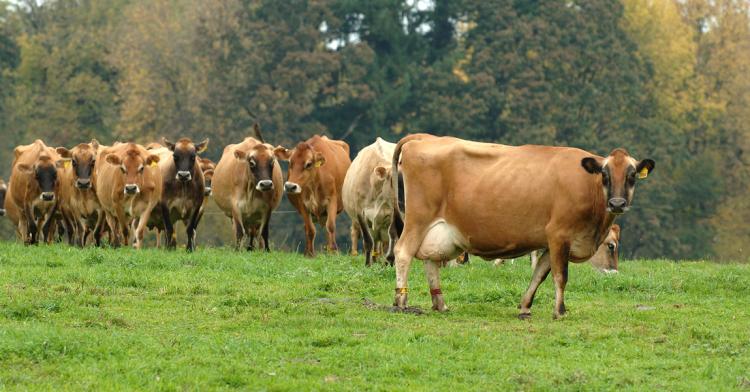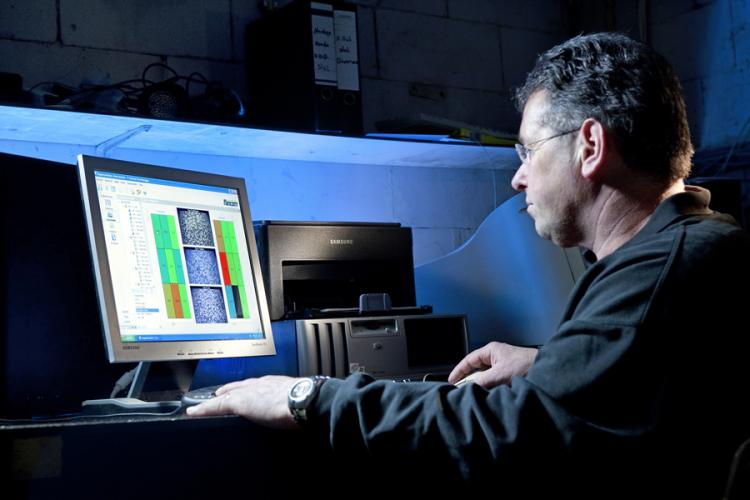Farm animals hold an unusual place in society: They are both creatures and commodities, animals that live and die to support the global economy and a burgeoning human population hungry for protein. Their fates may be inevitable, but the quality of their lives can vary dramatically, from cows grazing green pastures to hogs that never see daylight.
The health and happiness of farm animals has become an important cause for animal-rights activists and an increasing number of consumers, but experts say that improving the lives of pigs, chickens and cows isn't just a moral issue. Faced with public pressure, new government regulations and an evolving agricultural system moving further and further away from the small family farm, farmers will have to rededicate themselves to animal welfare to protect their own bottom line.
“It's a cool and exciting time to be involved in agriculture,” says Daniel Weary of the University of British Columbia in Vancouver. “There's a growing interest in farming and where our food comes from. We're taking a step back and questioning some of the things we've done for a long time.”
And though opinions differ, some experts think that improving the lives of farm animals could be an important step not just for farmers and animals but toward feeding and protecting the planet.

Cows in a field at an organic dairy farm in Oregon.
CREDIT: PHOTO BY LYNN KETCHUM / OREGON STATE UNIVERSITY
The cost of caring
Most farmers and ranchers already take animal welfare seriously, Weary adds. But caring for animals isn't cheap, and any large-scale attempts to improve welfare would likely come with a large price tag. In a 2017 report in the Annual Review of Resource Economics, Harald Grethe, an agricultural economist at Humboldt University in Berlin, estimated that livestock producers in the US and Europe can easily sink 30 percent to 40 percent of their total production costs into the welfare of their animals. A German agency estimated that it would take an investment of €3 billion to €5 billion ($3.7 billion to $6.1 billion) to ensure that all animals had amenities like room to move and the chance to perform natural feeding and grooming behaviors. And that's in a country where standards are already relatively high. In other parts of the world, the costs — and the need — could be significantly higher.
A growing awareness about farm animal welfare has already improved the lives of some animals, but it has also heightened the conviction that the status quo isn't acceptable. As Grethe writes, “It is widely accepted in many countries that the farm animal welfare level needs to be substantially improved.” He adds: “Humans have certain duties to animals.”
Under pressure to change
Spurred on by public demands, federal and state governments have stepped in to improve the health and well-being of farm animals. Some new laws target obviously dubious practices: Starting in 2019, German farmers will no longer be able to castrate pigs without anesthesia. A California law enacted in 2015 requires that all chicken cages, veal crates and sow gestation crates give animals enough space to “turn around freely, lie down, stand up and fully extend their limbs.”
Not all farmers will be eager to make such investments of their own accord, but to face the future, they'll need to make animal welfare a priority, says Daniel Berckmans, a bioscience engineer at the University of Leuven in Belgium. Berckmans explains that stress and disease slow the growth of animals, and most livestock fall about 30 percent short of their genetic potential as a result. Healthier, happier animals could put on more weight with the same amount of feed, a huge advantage in an industry where profit margins per animal are often razor-thin.
But there could be more at stake than profits. Roughly 65 billion cows, pigs and chickens are slaughtered every year to provide protein to humans, a harvest that already puts a significant environmental strain on the planet. The Food and Agriculture Organization of the United Nations estimates that the demand for meat could jump 70 percent by 2050, which would send even more animals to the slaughterhouse, a situation that may be unsustainable. “That would be a disaster, just from the manure and the emissions,” Berckmans says. “It's hard to accept killing 100 billion animals a year.”
Instead of jamming more animals into already crowded facilities, Berckmans says that livestock producers could take a big step toward meeting global demand by simply treating their animals better. “Animal welfare is the key to making the process more efficient,” he says. “It took me many years to understand this.”
Weary, for his part, has dedicated his career to improving farm animal welfare to help not so much the world as the animals and the farmers. He says that developed countries already consume far more protein than they really need, so bulkier pigs and cows may not be crucial to the future. “I'm skeptical of the narrative that we have to do X and Y to feed the planet,” he says.
Large-scale precision
Advances in technology could help farmers improve lives of animals, and with it, their own. Since the early 1990s, Berckmans and colleagues have been working on precision livestock farming (PLF) systems that monitor large numbers of farm animals and provide real-time warnings about infections, injuries and other breakdowns, giving farmers a chance to act quickly to prevent a crisis. For example, a camera system called eYeNamic can constantly track the movement patterns of 30,000 or so chickens in a single barn, potentially saving the farmer a lot of time and visits with the birds.
In tests conducted on European farms in 2016, Berckmans and his team found that the eYeNamic system detected 95 percent of all problems, including diseases, blocked feeder lines and other disruptions to the normal flow of activity in the barn. “We convinced ourselves that the technology works,” he says. The system isn't yet cost effective, but he believes that prices will go down as technology matures. “Five years from now, PLF will have proven its value,” he says.

Technological advances could allow farmers to monitor animals remotely and rapidly detect problems such as blocked feeder lines, infections or injuries. In this image, a user monitors poultry with a system known as eYeNamic that can track thousands of chickens at a time.
CREDIT: FANCOM B.V.
Berckmans is working on other potential solutions as the chief technology officer of BioRICS, a Belgian company that makes wearable stress monitors for athletes, including the members of the AC Milan soccer team. He envisions a time when such individual monitors will be common accessories for cows and other farm animals. “This will be crucial for making the system more efficient and more acceptable to the general public,” he says.
The coming megafarm
PLF or other innovations could become increasingly important as small family farms continue to give way to larger industrial operations, Berckmans says. With the number of farmers on the decline and the demand for food on the increase, he foresees the rise of animal metropolises with perhaps 25,000 milking cows, 200,000 pigs or a few million chickens in a single facility. Despite widespread concerns about the horrors of “factory farms,” animals at large facilities aren't necessarily worse off than those on smaller farms (see sidebar). Still, such large facilities will produce challenges for animal welfare. A single infection, for instance, could quickly spread through an entire flock or herd, increasing the need for careful monitoring and rapid response.
Evolving attitudes about animal welfare could also change the way things are done on the farm, Weary says. “People are going back to the issue with fresh eyes. You don't want to have your customers or your neighbors walk up to you and say that what you're doing is against their values.” He says that the dairy farmers he works with generally agree that their cows would be healthier and happier if they had regular opportunities to graze in pastures, and widespread demand for milk from pasture-fed cows could make it worth farmers' while. “It's an opportunity for them to do something that perhaps they want to do anyway,” Weary says.
The grocery store would seem like an obvious place for consumers to support animal welfare, but making such a statement isn't simple, says Jayson Lusk, an agricultural economist at Purdue University in West Lafayette, Indiana. Some people may decide to reduce suffering on the farm by going vegan. That might reduce the number of animals headed for slaughter, he says, but it doesn't do much to improve the lives of the animals that still go from farm to table. Consumers can shop for foods with reassuring labels such as “cage-free” eggs, but that term doesn't necessarily mean hens are living in a chicken utopia. In many cases, hens that avoid cages end up in huge flocks. That might give them more room and more opportunities to act like chickens, but they also tend to be more likely to break bones or die prematurely.
And then there's the cost: In a 2017 report in the Journal of Agricultural Economics, Lusk and a colleague estimated that the California law that gave chickens more room will cost consumers roughly $25 million a year in higher egg prices.
In the end, Lusk says, every animal's ability to grow and produce will be inexorably tied to its living conditions. “You have to make sure the animals are healthy enough to be able to put on weight and lay eggs and give milk,” he says. But as long as farmers can improve their profits by crowding more chickens or pigs into a barn, he says, the lengths they'll be willing to go to nurture and protect each animal will remain an open question. “There's always a trade-off.”




